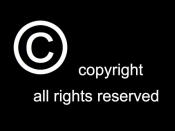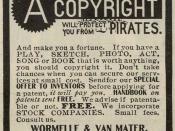We have all glanced, maybe for an instant, at the very fine print at the beginning of a book, and thought nothing of it. Many of us may have noticed on a product or at the bottom of a website a little é symbol and paid no attention to it. Some individual may have done a great deal of work to write a book, make a website or design a product. They want to therefore protect their finished result, the process it took to get there, and even the idea in and of itself. This type of protection is called copyright. This protection is so vast and legalistic that I will focus mainly on the following: what is copyright; its benefits and origins, how does one go about copyrighting something, differences between -copyrights, trademarks, and patents- and the consequences of copyright infringement.
Copyright is described by World Book 2004, as being "a body of exclusive rights that protect the works of authors, artists, computer programmers, and other creative people against copying or unauthorized public performance."
According to the Canadian Copyright Act, artistic work includes paintings, drawings, maps, charts, plans, photographs, engravings, sculptures, works of artistic craftsmanship, architectural works, and compilations of artistic works. A copyright provides the creator of the copyrighted material the sole right to copy, publish, perform, reproduce, adapt, translate, digitize, broadcast or transmit. Once a creator has ownership of a copyright, he or she can keep it or authorize others to use or buy it from the owner.
In the United States, modern copyright law originated in the United Kingdom in the year 1709. The American Copyright Act was passed by congress in the year 1790. Canada had similar ideas about protecting their artists, their works and ideas and they passed the Canadian copyright Act in...



Great
Well written and infomative, i found this essay very useful and I'm sure many others will find it useful too, congratulations.
2 out of 5 people found this comment useful.